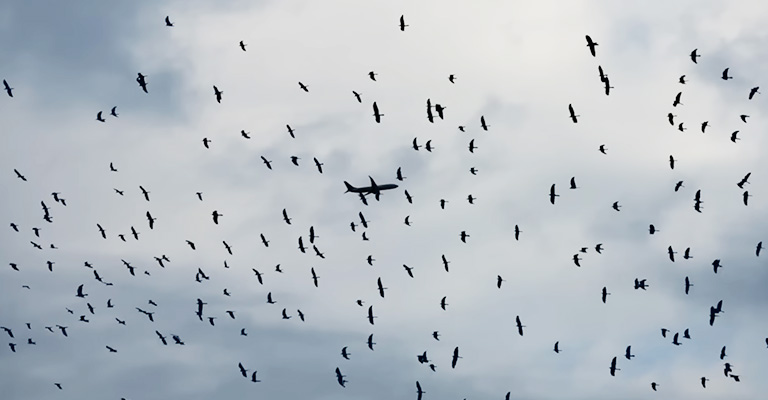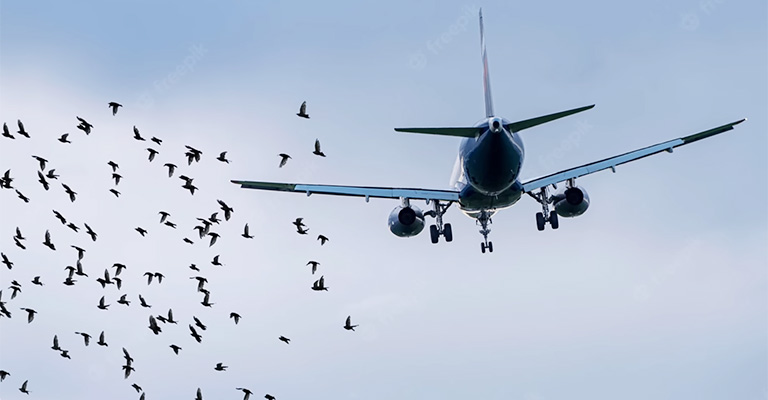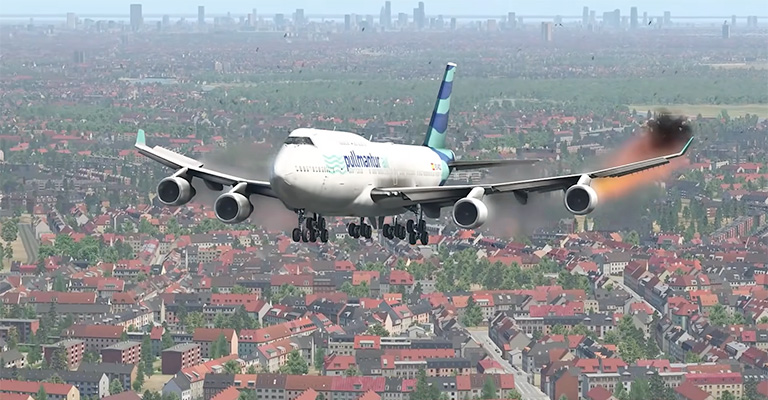The skies that serve as a thoroughfare for human transportation are also inhabited by countless species of birds. However, an unusual and potentially hazardous phenomenon has captured attention: instances where birds attack planes.
These occurrences, seemingly at odds with the natural behavior of birds, raise intriguing questions about the underlying reasons and mechanisms behind these attacks.
The clash between the avian world and modern aviation prompts a closer examination of the factors that drive birds to engage in behaviors that can pose risks to aircraft and passengers alike.
Let’s discuss why were birds attacking planes.

Why Were Birds Attacking Planes?
Birds are amazing creatures that can fly in the sky, but sometimes they can pose a threat to aircraft.
Here are some reasons why birds attack planes:
Territorial Defense
Birds, particularly during nesting season, might perceive an approaching plane as a threat to their territory. When aircraft enter their airspace, birds may respond defensively, especially if they feel their nests or young are in danger.
Protective instincts can trigger aggressive behaviors, leading to attacks on planes in an attempt to drive away the perceived threat.
Mistaken Identity
Birds’ visual perception isn’t the same as humans’. Some birds might misinterpret the size and speed of a plane, mistaking it for a potential predator or another bird intruding on their territory.
This confusion could lead to defensive or territorial aggression, resulting in bird-plane collisions.
Disruption of Flight Paths

Birds have established flight paths and patterns in their habitats. The sudden appearance of a plane can disrupt these paths, leading to confusion and stress among the birds.
In response, they might attack the plane as a way to regain control over their airspace and maintain their established flight routes.
Protection of Food Sources
Certain bird species, like gulls, are scavengers and forage near airports and landfills. Planes may unintentionally disturb their feeding grounds, prompting defensive behaviors to protect their food sources.
This competition for resources could escalate into attacks on planes that are perceived as encroaching on their feeding areas.
Mirror Aggression
Some birds exhibit territorial behaviors toward reflective surfaces, mistaking their own reflections for rival birds.
Aircraft surfaces, especially those with reflective coatings, might trigger territorial aggression as birds perceive their own reflections as intruders, leading to attacks on the plane.
Bird attacks on planes often result from a combination of instinctual behaviors, territorial defense, disrupted flight patterns, and mistaken identities.
Understanding these interactions can help airports and aviation authorities implement strategies to reduce the risk of bird-plane collisions and enhance aviation safety.
Can A Bird Cause A Plane Fire?

Here are some discussions on can a bird cause a plane fire-
Engine Ingestion
Bird strikes, where birds are sucked into the plane’s engines during takeoff or landing, can lead to engine damage and even fires.
When a bird is ingested into the engine, it can disrupt the engine’s operation, potentially causing parts to overheat or malfunction and sparking a fire.
Impact on Fuel Systems
Bird strikes can also impact the aircraft’s fuel systems. When a bird collides with a fuel tank or fuel line, it can rupture the system, leading to fuel leakage.
Then the leaked fuel comes into contact with a hot engine part or electrical components, it can ignite and result in a fire.
Electrical Systems Damage
Bird strikes can damage the aircraft’s electrical systems, including wires and sensors.
If a bird collides with these components, it could cause electrical malfunctions, which might lead to sparks and subsequent fires if the damaged wiring interacts with flammable materials.
Debris Induction
Bird strikes can cause bird remains or debris to be thrown against various parts of the aircraft, including hot surfaces.
The impact is forceful enough, it can generate heat and friction, potentially igniting surrounding materials and starting a fire.
Structural Damage
In rare cases, large bird strikes can cause significant structural damage to the aircraft.
This damage might expose sensitive internal components to external elements or create conditions where electrical faults can occur, potentially leading to fires.
While bird strikes are a concern, modern aircraft are designed with safety measures to minimize the risk of fires caused by bird collisions.
Regular inspections, improved engine designs, and proactive wildlife management strategies near airports are among the steps taken to reduce the likelihood of bird-related plane fires.
What Happens When A Bird Strikes A Plane?

Here’s what happens when a bird strikes a plane-
Impact and Damage
When a bird strikes a plane, the impact can cause varying degrees of damage depending on the size of the bird, its speed, and the part of the aircraft it hits.
The force of impact can dent or puncture the plane’s exterior, crack the windshield, damage control surfaces, or even enter the engines.
Engine Ingestion
One of the most concerning outcomes is when a bird is ingested into the plane’s engines. The bird’s body, bones, and feathers can disrupt the engine’s airflow and damage its components.
This can lead to reduced engine performance, overheating, and even engine failure if not managed promptly.
System Malfunctions
Bird strikes can also cause malfunctions in various aircraft systems. Electrical systems, hydraulics, and avionics can be affected if bird debris damages sensors, wires, or components. These malfunctions might impact the plane’s performance, stability, and safety.
Cabin Effects
Passengers and crew might feel and hear the impact of a bird strike, which could be jarring and alarming.
In some cases, the impact might cause minor turbulence-like sensations. Depending on the severity of the strike, passengers might observe damage to windows or the exterior of the plane.
Pilot Response
Pilots are trained to handle bird strikes and are usually prepared to respond quickly and appropriately.
They might perform safety checks, assess the extent of damage, and communicate with air traffic control. In severe cases, they might decide to return to the airport for a precautionary landing.
Post-Strike Inspections
After a bird strike, the plane undergoes thorough inspections to assess the extent of the damage. Maintenance crews examine the exterior, engines, systems, and structural components.
If necessary, damaged parts are repaired or replaced to ensure the aircraft’s continued airworthiness.
Overall, while bird strikes are a potential hazard for aviation, modern aircraft designs, bird management protocols, and pilot training, all contribute to minimizing the risks associated with such incidents.
FAQ
Birds might attack planes due to territorial defense, as they perceive aircraft as threats to their nests or young.
Mistaken identity, habitat disruption, and mirror aggression can also lead to aggression towards planes, as birds misinterpret reflections or unfamiliar objects as intruders.
No specific bird species consistently attack planes. Attacks can occur with various species, but large birds like gulls, hawks, and vultures are often involved due to their size and potential impact on aircraft.
Yes, bird attacks can damage planes. Strikes can dent exteriors, crack windshields, damage engines, and affect aircraft systems. Engine ingestion and structural damage pose significant risks, potentially compromising flight safety.
While bird attacks themselves might not directly endanger passengers, the potential damage caused by collisions can impact flight stability and safety. Pilots are trained to handle bird strikes and ensure passenger well-being.
Airports use bird management strategies such as habitat modification, scare tactics, and radar systems to deter birds from runways and flight paths. Pilots adhere to bird strike protocols and maintain vigilance during takeoff and landing.
Conclusion
The curious phenomenon of birds attacking planes underscores the complex interactions between human activities and the natural world.
As air travel becomes more prevalent, bird-plane interactions require careful attention and mitigation efforts. Balancing the preservation of bird habitats and migratory patterns with aviation safety remains an ongoing challenge.
In unraveling the motivations behind bird attacks on planes, we gain not only insights into avian behavior but also a reminder of the delicate harmony we must strive to maintain between human progress and the intricate ecosystems that share our skies.